AV Combiner and AV Router blocks
The video partitions of Tesira configuration files exist as control layouts for video and audio stream routing. The blocks in video partitions work differently behind the scenes than DSP blocks in audio partitions. AV Router and AV Combiner blocks do not directly process streams from the AVB network. Instead, they facilitate control by directing which TesiraLUX OH-1 decoders are listening to the desired AVB streams. The AVB network is handling stream routing based on how the control layout is programmed and which routes are dynamically selected. The AV routing blocks do not truly exist in the stream path and in this way are considered virtual blocks.
This article provides best practices for using the AV Router and AV Combiner blocks in video partitions.
AV Combiner
The AV Combiner block does not have initialization properties, dialog controls or any device allocation. It will combine one video stream and one audio stream into a combined AV stream signal path. Behind the scenes, it is simply a control that instructs the downstream AV Output blocks which video and audio streams to combine from the AVB network.

In this case, the signal path identifier shows use that the yellow video stream and red audio stream are combined in to a single AV stream. The AV Combiner can be used to embed an audio stream received from audio partitions. Partition connectors can be used in conjunction with the AV Combiner to de-embed HDMI audio streams, process them in an audio DSP and return the processed audio to the HDMI outputs.

One application where this is useful is capturing all of the audio and video media of a Tesira system. The microphone audio and video of the room can be sent over a single HDMI connection to a digital video recorder, video codec, or broadcast systems.
The AV Combiner can also be used to combine the auxiliary line inputs of an IDH-1 with the HDMI video. There are no limits to the number of AV Combiner blocks in a Tesira system. The AV Stream output node can also be fanned out to multiple connections. The Combiner can be used in conjunction with AV Routers and partition connectors to create complex signal routing.
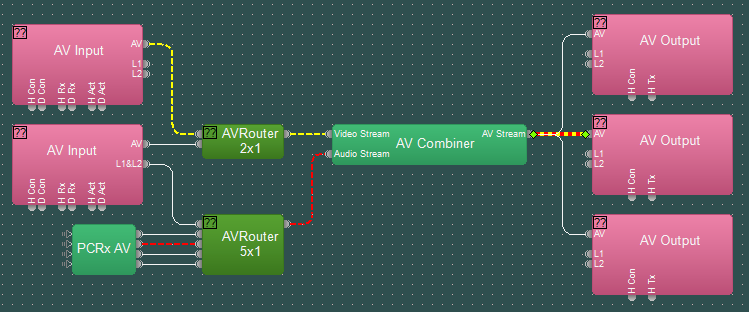
The AV Router block can be attached before and/or after AV Combiner blocks. AV Combiner blocks are not available in audio partitions.
AV Router
The AV Router provides stream routing functions on the configuration layout. It is considered a Virtual Router. The AVB network is actually handling the stream routing; the AV Router block is simply telling the network where to route the streams. The block can be initialized with custom numbers of inputs and output streams. The maximum AV Router size allowed in Tesira Software is 512x512. A block of this massive size, even a 64x64 router, can become unwieldy to work with. Several AV Routers can exist within a single partition and each can be different sizes. This can provide better design organization, easier creation of routing presets, and less complex implementation of third party control automation. AV Router blocks can be attached to AV I/O blocks, AV Combiners, and partition connectors. AV Routers can also be connected to each other to create complex routing selections, instead of controlling everything through one massive block.
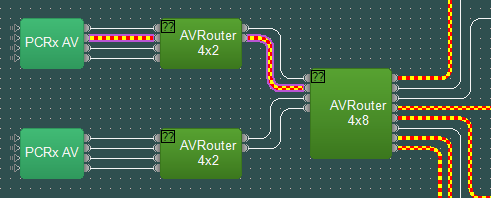
AV Router Device Allocation
While the AV Router is a virtual block, it must be allocated to a host device. The host devices will issue routing commands on the control network. In the example below, the AV Router block is allocated to Unit 1.
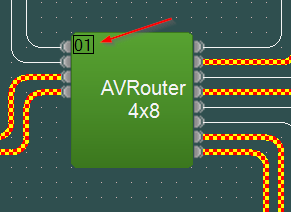
AV and Aux Audio streams from Unit 1 do not actually pass through Unit 2 to reach the destination AV outputs. Instead, the AV Router is directing the TesiraLUX OH-1 outputs to listen for the correct streams on the AVB network. If unit 2 is removed from the control network, that AV Router control will cease to function. For this reason, the AV Router block should always be allocated to a unit that will not be taken offline.
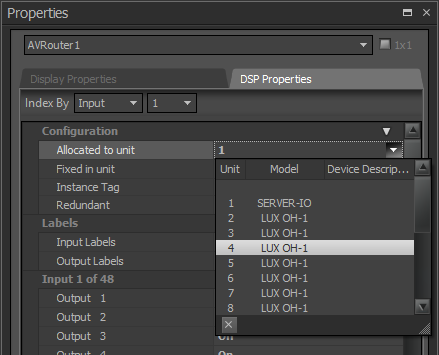
The AV Router can be allocated to TesiraLUX devices on other partitions of the configuration. It can also be assigned to Tesira audio devices, but this would consume some of the audio DSP resources. It is always best practice to allocate the AV Router to TesiraLUX devices within the same partition.
AV Router Feedback Loop
It is not possible to create an actual feedback loop with AVB streams and TesiraLUX. However, there are conditions that would result in a loop between audio partitions and multiple video partitions. Tesira Software will prevent the user from connecting partitions in ways that would allow a loop conditions. Multiple AV Router blocks in combination with partition connectors, or split pass-thru blocks, will result in possible feedback loop conditions.
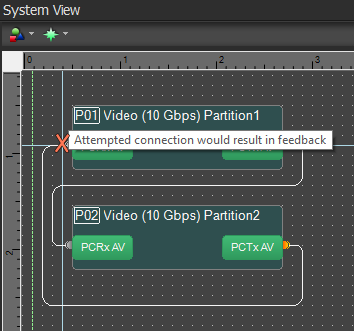
In this scenario, there are two identical video partitions that have partition Rx and Tx connections attached to an AV Router block.

When the two partitions are connected, there would be a control feedback loop. Software is preventing the user from making the connection because the router could be configured to create a loop condition. Moving the partition connections on both partitions would allow all video streams to route to all outputs without creating any loops.

Tesira is working with network streams that can be delivered via virtual routing to anywhere the network topology allows, instead of fixed circuit switching found in older video technologies. There are no trunking lines necessary in a video over IP system so the AV Router block can function in different ways than a fixed router. The design can utilize presets or control automation that can simultaneously change both AV Router blocks in both partitions to the desired routing. Changing the design results in a system with no loops.

